The Strait of Messina separates Sicily from the toe of Italy. It is narrower at the northern end (barely 1.5 nm) and wider at the southern end (about 7 nm). It also separates the Tyrrhenian Sea from the Ionian Sea and has a reputation, dating back millennia for fearsome whirlpools and winds whistling down the mountains that border it (e.g. Scilla and Charybdis in The Odyssey). Interestingly, the eddies in the Strait are largely attributed to differences in both salinity and temperature between the the Tyrrhenian (warmer and less salty) and Ionian Seas. We can certainly vouch for the Ionian Sea being quite a lot colder than the Tyrrhenian! Fishing for swordfish is common in the Strait during the months of May to July. Apparently the fish tend to snooze near the surface so the fishing boats have amazingly tall lattice “masts” with a basket atop from where the captain steers the boat and very long bowsprits from where the crew can harpoon the fish.
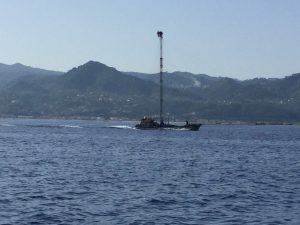
In light of the above, we timed our passage to the minute (almost) to arrive at Capo Pelora, at the northern entrance, at 4.5 hours after high water Gibraltar, as recommended in the cruising guide. As a result, the Strait turned out to be a bit of a non-entity for us. Yes, there were a few eddies and tidal rips but nothing to write home about. The upside was that the favourable current helped our speed south significantly. So, 9 hours after setting off from Milazzo we were greeted by George who manages mooring buoys in Taormina.
We knew very little about Taormina before we got there other than it was one of the first ports after Messina. It turned out to be a fascinating place with the town clinging onto the near vertical slopes between mountains, an ancient Greek/Roman theatre on top of a hill and a Norman castle atop an even higher hill, all with Mount Etna looming behind, puffing smoke from the summit, not to mention all the other historical buildings in between… We took a local bus up to both hills, an experience in itself when the bus took over the whole road at the multiple hairpin bends and the barrier between us and the vertical drop below was a mere 1 ft wall! We can definitely recommend visiting Taormina/Castemolo. One can learn so much more history visiting places. We were unaware that the Normans, within about 40 years of the battle of Hastings, had invaded Italy and traveled as far as Sicily, building the castle in Castelmolo. The Greco/Roman theatre, the second largest in Italy after Syracusa, must have the world’s most spectacular setting. The 2,000 plus years old theatre is still operational with international concerts being held throughout the summer. Jethro Tull, still around, is a forthcoming presentation! We had two very pleasant nights on the mooring and one rather rolly night when an easterly swell set in.
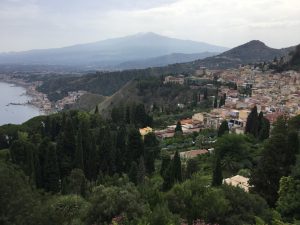

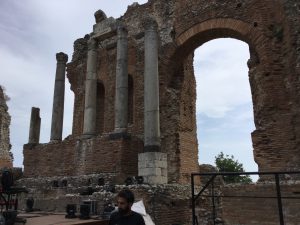
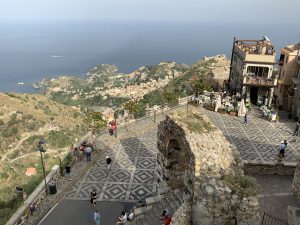
Our next port was Aci Trezza, a small fishing port with interesting basalt rock formations outside it, now a marine reserve. We most likely wouldn’t have contemplated docking there had it not been for our Canadian friends, John and Cora, who had been there a few days and found out that the town was celebrating their patron saint with the culmination of events being on Tuesday. J&C had also crossed the Atlantic on the ARC with us. It was our first time docking stern-to the harbour wall using our anchor to hold our bow off so we were a little nervous but it went well and we docked without incident.
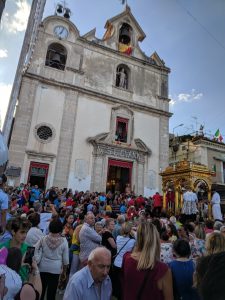
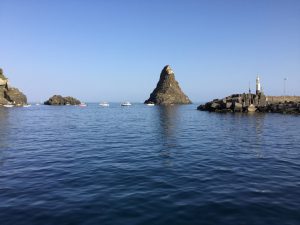
The church looks out onto the harbour towards two statues, one on the southern breakwater and the other on one of the basalt rocks outside the harbour. At 7pm on Monday, the day we arrived, the church bells rang and shortly thereafter there was an approx. 10-minute daytime firework display, a first for us during daylight hours, but quite impressive with loud bangs and colored smoke, of course in the Italian colors of red, white and green. But that was just the beginning because there were more fireworks at 11pm and 1:20am that night, 8am the following (Tuesday) morning, 7pm that night and the big show at 11:00pm. We happened to be ashore when the 7pm fireworks were let off. Again, the church bells rang, the statue of the patron saint on a plinth appeared at the church door, fireworks were let off and the crowd cheered. We had front row seats on our boats, just opposite the northern breakwater where all, bar a few, of the pyrotechnics were set off. Fortunately the wind was blowing the other way otherwise we would have had to have moved…. it was the most intense 10 minutes of fireworks we have ever seen.
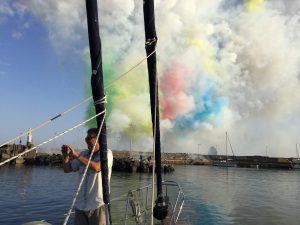
Now we are in Syracusa with Sonia onboard. We rented a car to pick her up from Catania airport and today used it to drive around Mount Etna and have a walk on one of the many lava flows that is a piste for skiing in winter months. We hope to explore more of Syracusa tomorrow and head to Porto Palo on Sunday.
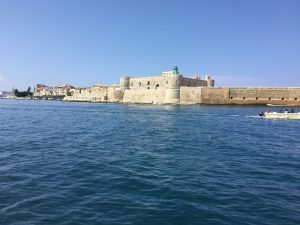
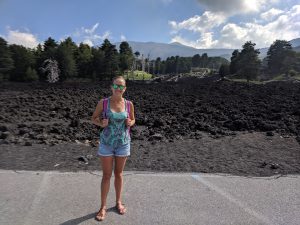
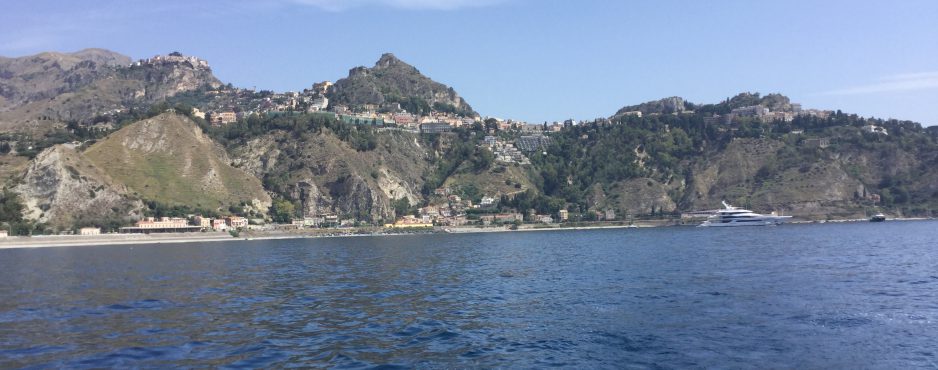
3 Comments
Cheryll
Wow that is spectacular. Would love to go to a concert in that amphitheater. Sicily is now on the places to visit list. Not sure about the transportation though! Have a great time with Sonia, sorry we wouldn’t have caught up with her here again in France. Trying to hide from the temperature but it’s following us. 40degrees expected today. Hope Italy is cooler.
Jerry Nigro
Cynthia and I spent 9 days in Sicily in May, we both loved it. It is so much fun to read about your adventures in place that we just visited. Reading all of your posts is great motivation to continue to see new places! Thanks!
Ruth and Nick Pearman
Completely fabulous this all looks and sounds. Wonderful of you to share it when you have your Sonia on board. Hope you are not melting yet! Think we will make another trip to Sicily as we had a taster of Syracusa in 2017.